Introduction
ASUS is known for many things; they make great enthusiast class motherboards and add-in GPUs. But how many people know they also make workstation and server class products? - We have known about this for a while and have finally gotten one in (complete with a socket 1156 Xeon for the CPU) for testing in our lab.
The P7P55 WS SuperComputer is a healthy system that also happens to have the ability to run a ton of GPUs at full x16 speeds thanks to an NF200 chip on the board. It is this multi-GPU capability that gives it the SuperComputer name. After all, if you are pushing four NVIDIA GPUs running CUDA or OpenCL, you have a massive amount of compute power at your fingertips.
Still, there is more to the P7P55 WS than just a bunch of PCIe x16 slots. So let's dive in and take a look at this $229.00 board from Newegg.com to see if it lives up to its name.
The Box and What's Inside
Package and Contents
The box the P7P55 WS SuperComputer arrived in was not too bad looking. It had a "13th Floor" look to it that I found cool. One thing I am becoming less of a fan of is the outer shell with an identical inner box. I agree that having that flap can clean up the packaging and allow more information, but it can be a tad much.
As you can see, under the flap is even more of the hard sell on the features of the P7P55 WS. We also want to bring the Tesla logo to your attention. This really does make the WS a SuperComputer if you drop three of these into the system.
More advertising on the box under that front flap.
The back of the box has a nice image of the board and a complete list of specs.
Inside the box you will find (after you buy one of course) a nice assortment of goodies. There is a three-way SLI bridge, a very long Crossfire bridge and a diagnostic module.
The diagnostic module has a pair of LEDs in addition to a power and reset button. It is a nice touch and allows for quick trouble shooting in the event of boot failures.
The Motherboard
The Board
As with just about every board on the market today, the P7P55 WS SuperComputer is an ATX form factor. It comes complete with all the advantages and disadvantages of this style of build.
Most companies have vastly improved on the ATX design by increasing the number of board layers. This allows the traces to be laid out in better isolation. This prevents high-speed cross talk and interference between the traces and increases stability. The addition of copper in the layers also acts as an additional signal dampener (in addition to added cooling).
ASUS went with a more functional design with the WS. Here you do not need fancy heatsinks or lights and whistles. Instead the design seems to convey durability. This is a board intended to last and work hard.
The CPU/Memory area is laid out in a very familiar way. You see the now standard one-armed RAM slots as well as numerous fan headers. A serial port header is placed in this area for some reason (maybe for a front header) while the 8-pin 12V Aux connector is sandwiched in between the top edge of the board and the upper VRM heatsink.
The lower half of the board shows us the multiple PCIe slots for use with Tri SLI or multiple Tesla cards. It is the support for Tesla in a multi-GPU configuration that lends the SuperComputer its name.
Another feature that is very workstation is the inclusion of two board mounted internal USB 2.0 ports. These are along the bottom edge and are intended for items like Encryption Keys and Security Dongles. As you can see in the image below, we used it for our LightWave 3D Dongle. This is nice as it puts these expensive and important devices safely inside a case and out of plain sight (and you can always get a case with a lock on the side panel).
As with other workstation boards from ASUS, we find that the handy diagnostic add-on fits right at the bottom edge of the board. Interestingly enough, it plugs into a slot labelled TPM. TPM stands for Trusted Platform Module, yet there is not a TPM chip on the diagnostic board. This little oddity will not affect performance and also will not stop you from using Bit Locker encryption; it is just one of those things I found odd about the board.
The ports on the P7P55 WS SuperComputer are fairly typical even if there are a tad more USB ports than you would normally see. The two LAN ports also stand out.
Overall I found the P7P55 WS SuperComputer to be a fairly well laid out board for the workhorse it is intended to be. I am not saying it is perfect, just that it is a little better than most when it comes to layout.
BIOS and Overclocking
BIOS
The BIOS on the P7P55 WS is the one we have come to know and love/hate from an ASUS board.
Most of the items you will be tinkering around with are located in the AI Tweaker section. This is a nice little area that has more than a few options for kicking any CPU you drop into the P7P55 WS into high gear.
One nice feature on the WS and other ASUS boards is the Q-Fan controls. We normally do not talk about fan profiles when we cover the BIOS, but this is one time where we thought it was worth the effort.
During testing I noticed that the fans seemed to be quite loud even at idle and with the EPU-6 software running. A quick check of the BIOS found the Q-Fan profile to be set to Turbo for the CPU fans. After a quick adjustment to Silent the system was whisper quiet (except for the GPU fan). For testing I turned the Q-Fan off, but it is a very nice feature and one that we do want to dive into in another review.
Overclocking
Overclocking the P7P55 WS SuperComputer was as easy as any ASUS board. I simply dropped into the BIOS and used the CPU Level up to get things started. Using this tool will generally give you more voltage than you need to be on the safe side for the speed you have selected. This is not a bad thing really, but I have found that you can often push much farther when even leaving the same voltage settings from a lower auto clock.
We chose 3.5GHz from the CPU Level up and then pushed on to 4.1GHz with only minor tweaks to the CPU Voltage and CPU PLL voltage. This is right around where you should be with this CPU when you leave Turbo Mode and Hyper Threading on. Unfortunately we did have to drop the RAM speed down; I am not completely sure why, but it did not want to run at anything other than 1120MHz when we pushed the CPU.
You can see the validation for the Xeon X3470 here.
TurboV
We have covered TurboV for you before, but this time we have something a little different to talk about. This new mode does not actually have a name; it is more of a custom DDR3-1600 mode. From my understanding this nice little feature allows you to hard set the memory to 1600MHz @ 1.65 Volts and from there take off and run with the overclock.
According to ASUS this is the most aggressive auto overclocking mode they have come up with to date. Due to time constraints we were not able to dive too deeply into this feature, but we did see it give an OC that was just below our high clock of 4.1GHz. This was much higher than the Auto Tuning when set to Easy or Extreme. Keep an eye out for our follow-on using this mode and some good high end DDR3-2000 RAM.
As all overclocking results are dependent on the hardware you use, your results may vary. Results of our overclocking tests are included in the performance section with the stock scores.
Important Editor Note: Our maximum overclocking result is the best result we managed in our limited time of testing the motherboard. Due to time constraints we weren't able to tweak the motherboard to the absolute maximum and find the highest possible FSB, as this could take days to find properly. We do however spend at least a few hours overclocking every motherboard to try and find the highest possible overclock in that time frame. You may or may not be able to overclock higher if you spend more time tweaking or as new BIOS updates are released. "Burn-in" time might also come into play if you believe in that.
Test System Setup and Comments
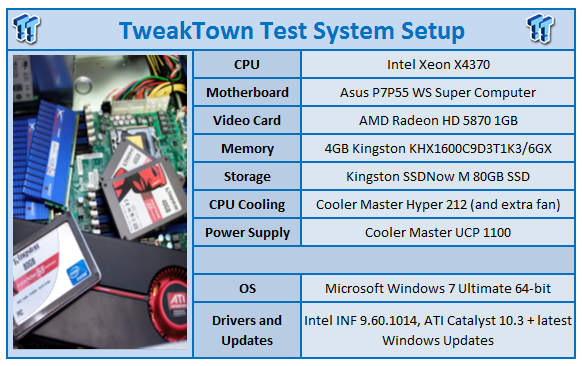
We would like to thank the following companies for supplying and supporting us with our test system hardware and equipment: Intel, ASUS, AMD, Kingston and Cooler Master and Sceptre.
The P7P55 WS SuperComputer was easy to work with. The layout provided ample room for the components that I installed. The multiple fan headers will come in handy to provide good air flow, even for a system with NVIDIA's Tesla space heaters inside. Software and driver installation was taken care of by the ASUS "install all".
Synthetic Tests - Part I
With any system you will want to see a combination of synthetic testing and real-world. Synthetics give you a static, easily repeatable testing method that can be compared across multiple platforms. For our synthetic tests we use Everest Ultimate, Sisoft Sandra, FutureMark's 3DMark Vantage and PCMark Vantage, Cinebench as well as HyperPi. Each of these covers a different aspect of performance or a different angle of a certain type of performance.
Memory Bandwidth
Memory is a big part of current system performance. In most systems slow or flakey memory performance will impact almost every type of application you run. To test memory we use a combination of Sisoft Sandra, Everest and HyperPi 0.99.
Sisoft Sandra
Version and / or Patch Used: 2010c 1626
Developer Homepage: http://www.sisoftware.net
Product Homepage: http://www.sisoftware.net
Buy It Here

Memory bandwidth is not too far off what we should be seeing with the memory we used here. The performance drops off during our OC testing due to having to use a more drastic divider to maintain stability.
Everest Ultimate
Version and / or Patch Used: 5.30.1983
Developer Homepage: http://www.lavalys.com
Product Homepage: http://www.lavalys.com
Buy It Here
Everest Ultimate is a suite of tests and utilities that can be used for system diagnostics and testing. For our purposes here we use their memory bandwidth test and see what the theoretical performance is.
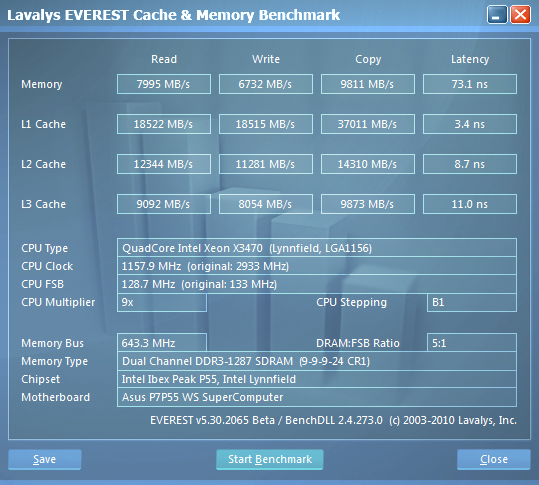
Stock Memory Performance
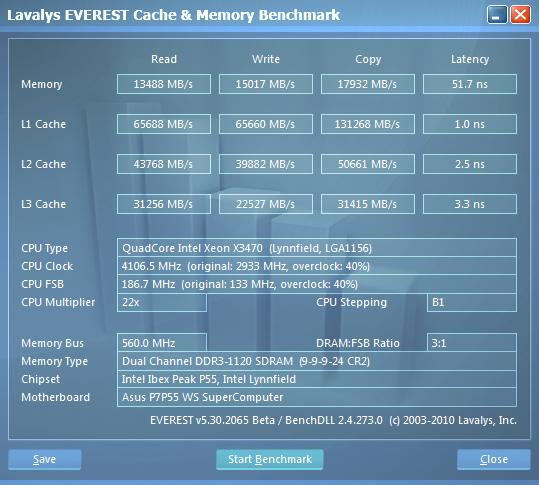
Overclocked Memory Performance
Again we see the same memory performance we saw with Sandra. The drop during overclocking might come back to haunt us in other tests.
HyperPi 0.99
Version and / or Patch Used: 0.99
Developer Homepage: www.virgilioborges.com.br
Product Homepage: www.virgilioborges.com.br
Download It Here
HyperPi is a front end for SuperPi that allows for multiple concurrent instances of SuperPi to be run on each core recognized by the system. It is very dependent on CPU to memory to HDD speed. The faster these components, the faster it is able to figure out the number Pi to the selected length.
For our testing we use the 32M run. This means that each of the four physical and four logical cores for the i7 and the four physical cores of the i5 is trying to calculate the number Pi out to 32 million decimal places. Each "run" is a comparative to ensure accuracy and any stability or performance issues in the loop mentioned above will cause errors in calculation.
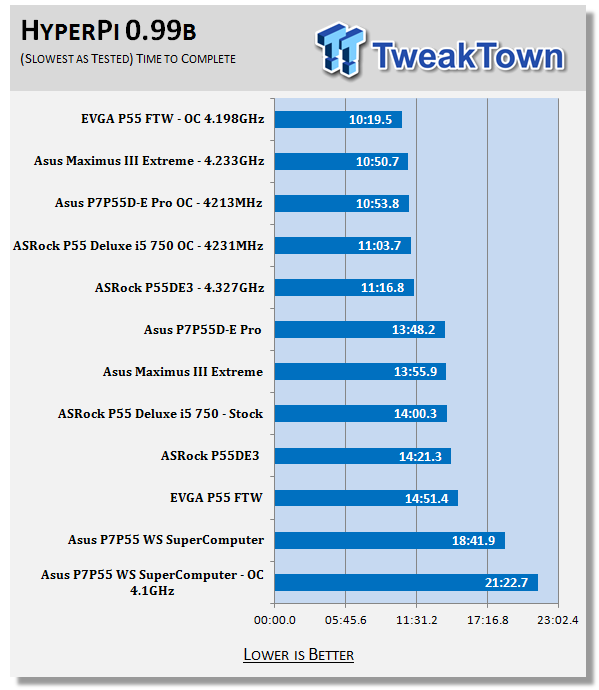
Now, when you look at this chart you are going to think that the P7P55 WS is not a very good board for Hyper Pi. However, it is very important to note that the Xeon X3470 we used is running two 32M instances per core. That all by itself is extremely impressive, so those numbers are actually pretty good for the work load.
Synthetic Tests - Part II
Disk Drive Controller
The system drive controller is an important part of system performance. In most modern boards your drive controller will run off of the PCI-e bus. The PCI-e bus performance can be affected by poor trace layout as well as many other design choices that show up on different boards.
For testing we use Sisoft's Sandra and Everest.
SiSoft Sandra

The P7P55 WS has excellent HDD performance; it comes in at the top of the group for the P55 range. This is good news for AV editors and other content creators.
Everest
Stock HDD Performance
Overclocked HDD Performance
Everest backs up our HDD findings from Sandra. This is one fast board for SATA II HDD performance.
Synthetic Tests - Part III
Here is where we dig out the FutureMark tests.
PCMark Vantage
Version and / or Patch Used: 1.0.0.0
Developer Homepage: http://www.futuremark.com/
Product Homepage: www.futuremark.com
Buy It Here
For overall system performance we use PCMark Vantage. This is run in both x86 and x64 mode to give the best indication of performance.
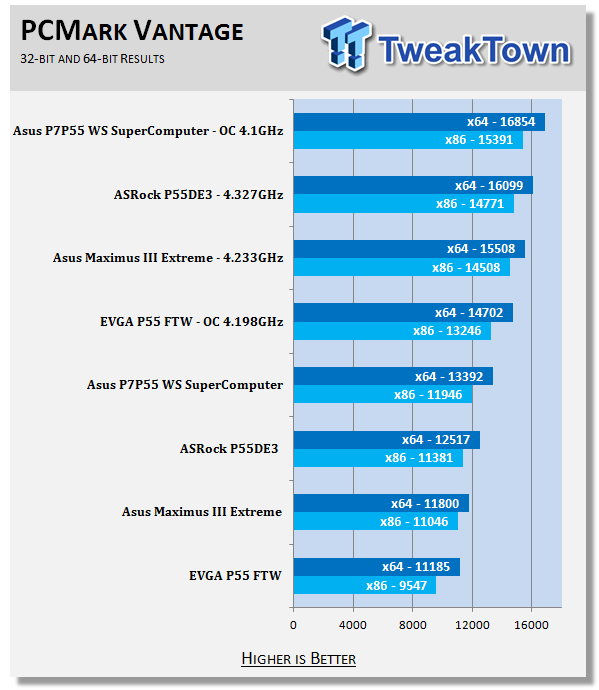
All I have to say is, nice! - The P7P55 WS tops out both the stock and overclocked categories. Even with the memory bandwidth limited this board shines and pulls off a win.
3DMark Vantage
Version and / or Patch Used: 1.0.1
Developer Homepage: http://www.futuremark.com/
Product Homepage: www.futuremark.com
Buy It Here
For synthetic gaming tests we used the industry standard and overlockers bragging tool 3DMark Vantage. This is a test that strives to mimic the impact modern games have on a system. Futuremark went a long way to change from the early days of graphics driven tests to a broader approach including physics, AI and more advanced graphics simulations.
3DMark Vantage uses the DX10 API in addition to having support for PhysX. As we are no longer using an NVIDIA GPU for testing (at least until we can get a GTX 4xx card) you will only see the CPU based PhysX results in the scores. For testing we use the Performance test run.
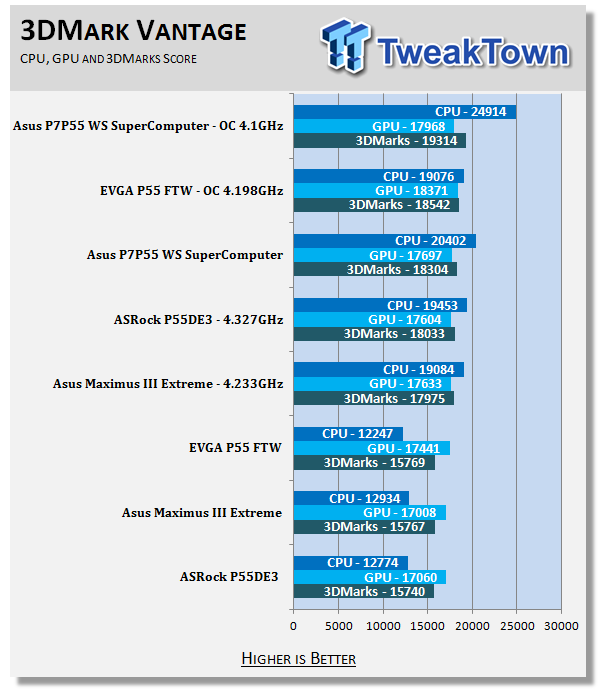
Another impressive showing from the P7P55 WS. Here even at stock speeds we see the WS outperform some of the other P55s while overclocked.
Cinebench R11.5 x64
Version and / or Patch Used: R11.5 x64
Developer Homepage: http://www.maxon.net/
Product Homepage: www.maxon.net
Download It Here
Cinebench is a synthetic rendering tool developed by Maxon. Maxon is the same company that developed Cinema4D, another industry leading 3D Animation application. Cinebench R11.5 tests your systems ability to render across a single and multiple CPU cores. It also tests your systems ability to process OpenGL information.
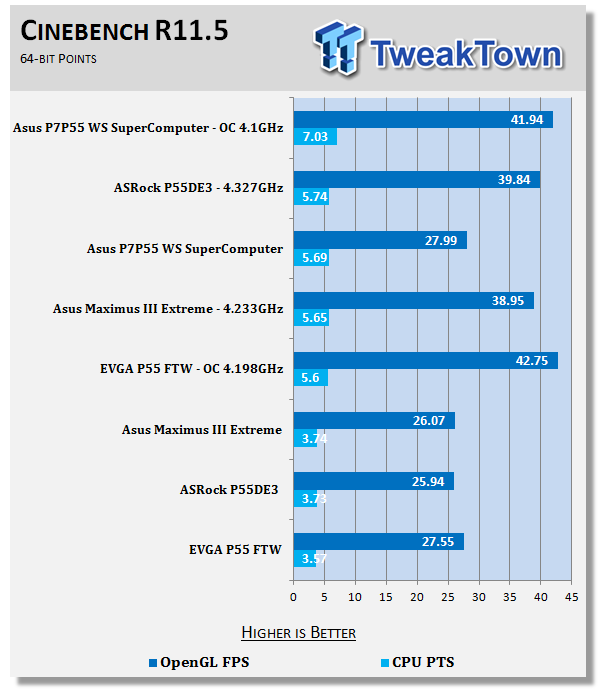
We were not surprised to see the P7P55 WS/Xeon X3470 combo come in with a win here. After all, it has four more threads to play with than the Core i5 750.
Real-World Tests - Part I
Real-world testing allows us to see how well a product will perform when used in the same manner as it would be in your house or office. It is an important side to performance testing as it can uncover hidden glitches in the way a product performs.
It is especially true when testing a mainboard; there are so many components of a board that have to interact that any problems between parts can cause a failure of the whole.
For real-world testing we use some common applications and functions. We test with LightWave 3D for rendering performance, AutoGK for transcoding from DVD to AVI and two games for gaming testing.
Rendering
Rendering of 3D Animation is a system intensive endeavor. You need a good CPU, memory and HDD speed to get good rendering times. For our testing we use LightWave 3D. This software from Newtek is an industry standard and has several pre-loaded scenes for us to use.
LightWave 3D
Version and / or Patch Used: 9.6
Developer Homepage: http://www.newtek.com
Product Homepage: http://www.newtek.com/lightwave/
Buy It Here
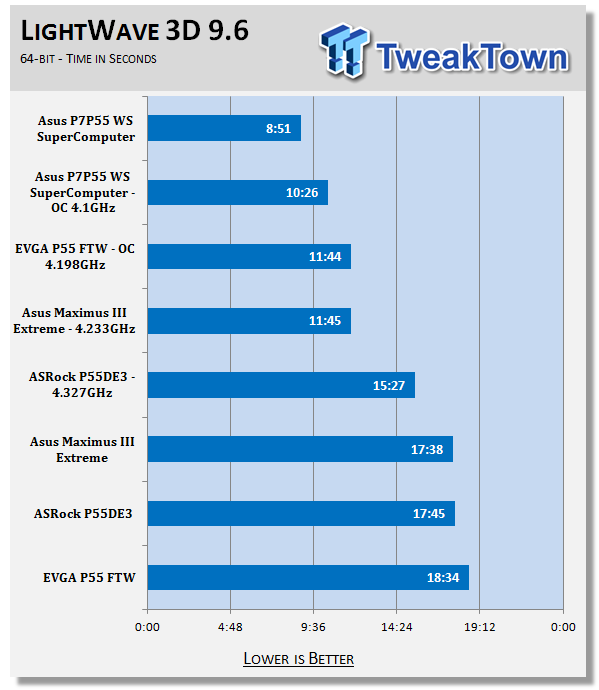
Again we were not shocked to see the P7P55 WS come out on top. Lightwave 3D when using the new perspective camera is much better at scaling across multiple cores and threads.
AutoGK
Version and / or Patch Used: 2.55
Developer Homepage: http://www.autogk.me.uk/
Product Homepage: http://www.autogk.me.uk/
Download It Here
AutoGK stands for Auto Gordian Knot; it is a suite of transcoding tools that are compiled into an easy to install and use utility. It allows you to transcode non-protected DVDs and other media to Xvid or Divx format. For our testing purposes we use a non-DRM restricted movie that is roughly 2 hours in length. This is transcoded to a single Xvid AVI at 100% quality.
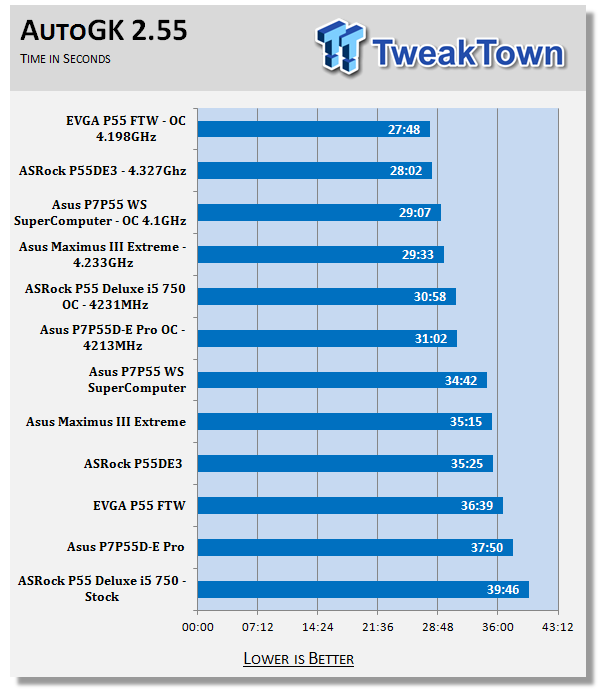
With AutoGK we see the excellent HDD performance help to push the P7P55 out in front. However, the lower memory bandwidth hinders it in our overclocked testing.
Real-World Tests Part II
Here we have our real gaming tests. Each of the games we chose use multiple cores and GPUs. They are able to stress the system through use of good AI. Both have decent positional audio that adds impact to the sound subsystem of the board. We ran each game through the level or parts listed and recorded frames per second using FRAPS. This brings the whole game into play.
*** A word on gaming as a motherboard test ***
Despite the fact that most games are very GPU limited, we are still noticing HDD and even audio creating issues in gaming performance. Because of this you may see differences in the number of frames rendered per second between different boards. Usually the difference is very small, but occasionally because of bad tracing, poor memory or HDD performance, this difference is significant. The issues are often more prevalent in older versions of DirectX, but can still pop up in DX10 and 11.
Call of Duty Modern Warfare 2 (DX9)
Version and / or Patch Used: 1.0
Timedemo or Level Used: First combat until the school is cleared
Developer Homepage: http://www.infinityward.com
Product Homepage: http://modernwarfare2.infinityward.com
Most of you know about the game Modern Warfare 2; it caused quite a bit of controversy in the latter half of 2009. The game is a first person shooter with a heavy combat emphasis. It follows the events in the first Modern Warfare very closely and brings back several characters from the original.
As with most games in the Call of Duty franchise, it features a heavy AI load. This is not because of a complex AI routine, but more due to the sheer number of enemies in any given combat situation. It is also our single DX9 based game in our testing suite. Settings are shown below.
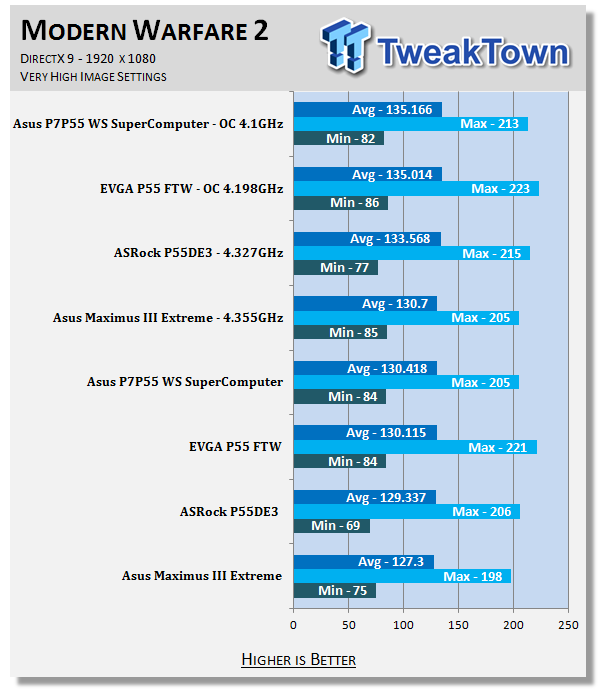
While we can call this a "win" for the P7P55 WS, it is not a big win. The average difference from top to bottom was a handful of FPS. At the speeds the game was running at it would not be noticeable in the real world.
Far Cry 2 (DX10)
Version and / or Patch Used: V1.00
Timedemo or Level Used: Clearing the Safe house through to the Rescue
Developer Homepage: http://www.ubi.com
Product Homepage: http://farcry.us.ubi.com
Far Cry 2 is a large sandbox style game. There are no levels here so as you move about the island you are on you do not have to wait for the "loading" sign to go away. It is mission driven so each mission is what you would normally think of as the next "level".
In the game you take the role of a mercenary who has been sent to kill the Jackal. Unfortunately your malaria kicks in and you end up being found by him. Long story short, you become the errand boy for a local militia leader and run all over the island doing his bidding. Settings we used for testing are shown below.
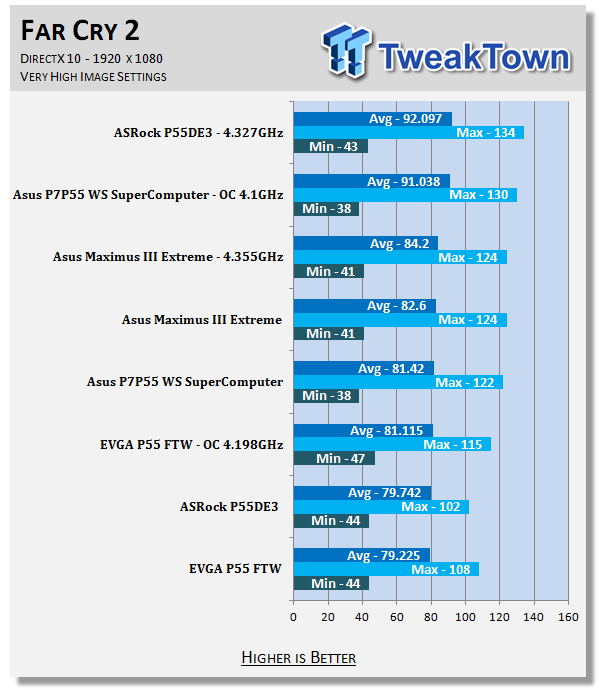
The P7P55 WS does well in Far Cry 2, but again the differences are less than 13 FPS from top to bottom. When you are in the 80-90FPS range is it unlikely that you would be able see that at all.
Battlefield Bad Company 2 (DX11)
Version and / or Patch Used: V1.00
Timedemo or Level Used: From washing up on the beach to the mine fields.
Developer Homepage: http://www.ea.com/
Product Homepage: http://badcompany2.ea.com/
Battlefield Bad Company is another sequel and also another game "franchise". Bad Company 2 is also our DX11 Shooter game. The game follows a fictitious B company team on a mission to recover a Japanese defector. This puts you back in World War II (at least for the beginning of the game) while the multi-player game is centered on much more modern combat. For our testing we used the single player mode. Settings are shown below.
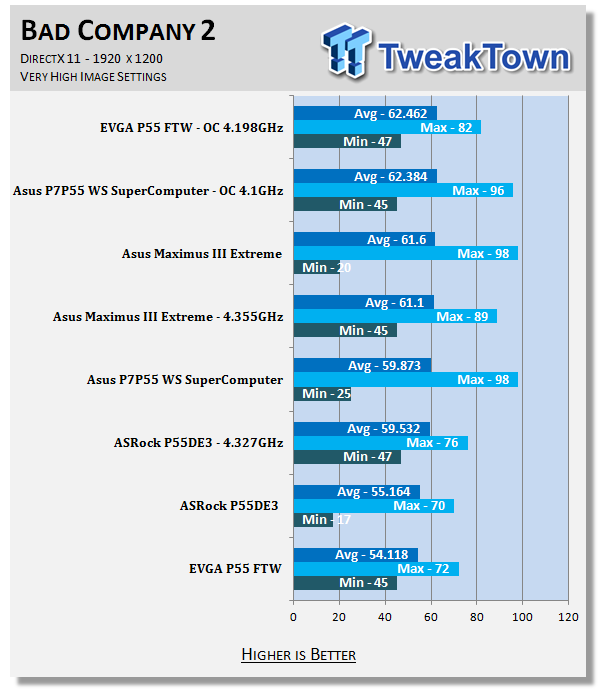
With less than 9FPS difference there is not much to say here. We can call a winner, but you would never know it to play the games side by side.
Gaming Conclusion
These days gaming is gaming. If you have the right GPU you will get good frame rates. The reason for this is that games are becoming more and more visually oriented. There is little improvement in AI and other items that demand CPU time and power.
One area that will still remain in the CPU realm is audio for onboard codecs. However, positional audio and surround sound are not often major features of games, so again the CPU and motherboard plays little part in gaming.
Still, we have to say that the P7P55 WS will not hold you back in your gaming endeavors. With the extra lanes for three way SLI and Crossfire it could actually be a great board for high end gaming (with monitors of 30-inches and up).
Power Usage and Heat Tests
Power Consumption
We are now able to find out what kind of power is being used by our test system and the associated graphics cards installed. Keep in mind; it tests the complete system (minus LCD monitor, which is plugged directly into an AC wall socket).
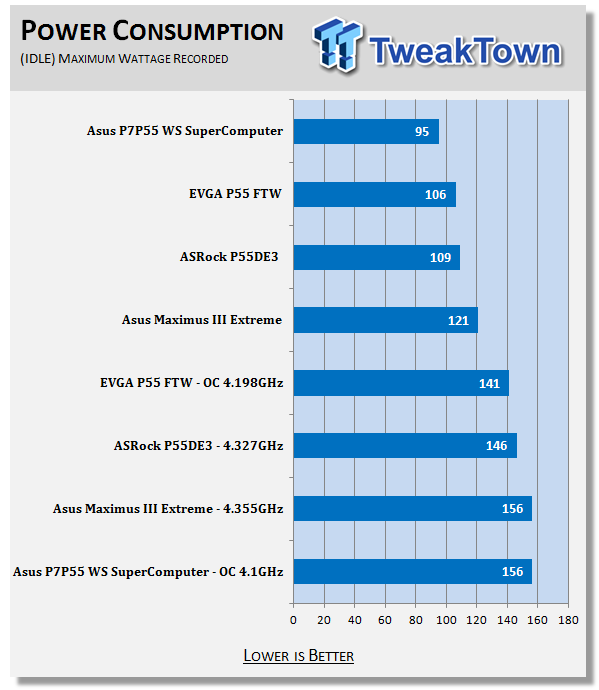
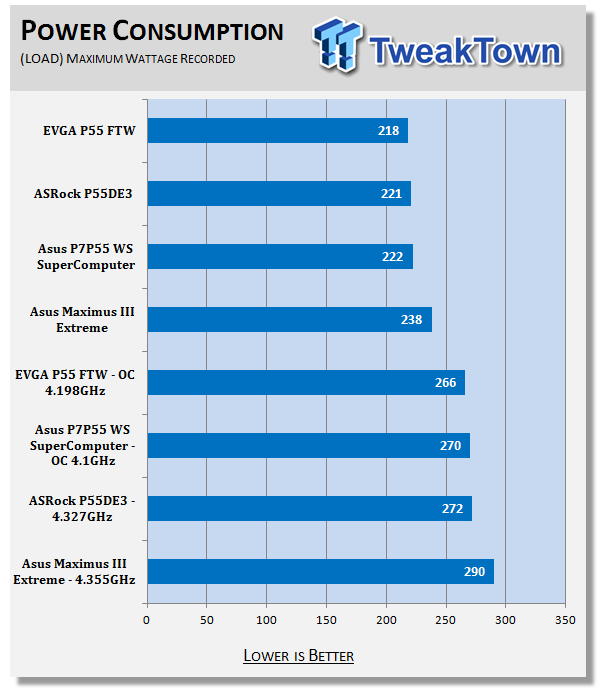
The P7P55 WS SuperComputer is very power efficient at stock speeds. This is thanks to the EPU-6 software and the ASUS EPU hardware. Of course, once we overclock the CPU all bets are off and the power usage picks up quickly.
Heat Generation
As a new measure, we are now monitoring the heat generation from the key components on the motherboard; this being the Northbridge, Southbridge (if it contains one) as well as the Mosfets around the CPU. The results are recorded at idle and load during the power consumption tests.
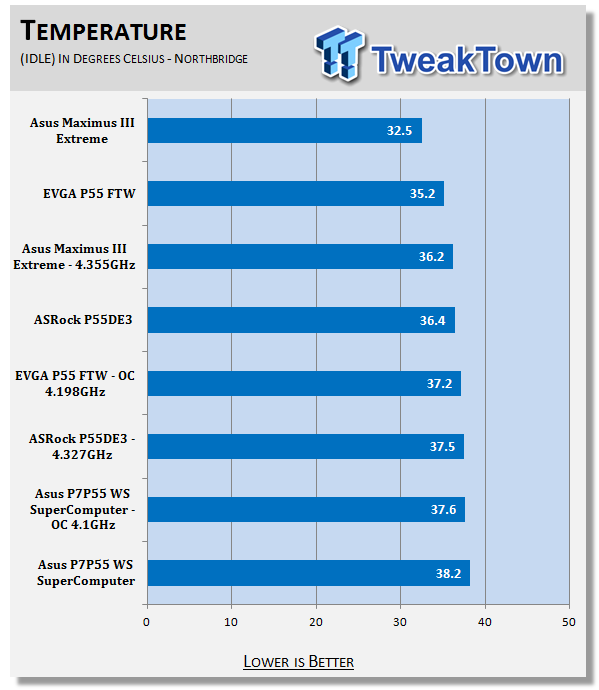
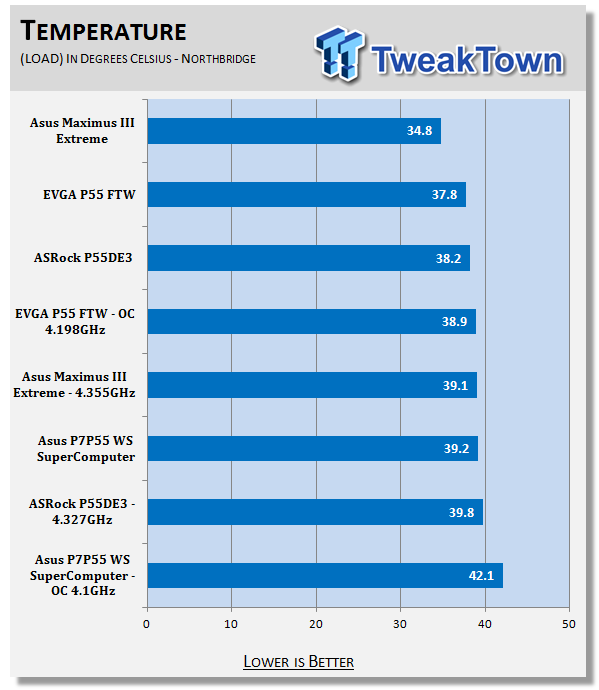
Heat generation was another matter. The P7P55 WS SuperComputer can put off a good deal of heat. This means that to keep this cool inside a case you had better make sure you have good ventilation and air flow (we told you all the fan headers would come in handy).
Final Thoughts
Hmmm, the ASUS P7P55 WS SuperComputer could possibly be very misnamed. It lists itself as a workstation system, yet it is more than capable of operating (very well) in a consumer level system. It is very versatile with the extra lanes for either SLI/Crossfire or for multiple Tesla cards. No matter what direction you want to go, the P7P55 WS seems suited to the task.
The layout is utilitarian and fairly clean. The extra two USB ports will be great for people that have to use security dongles for work (LightWave 3D and others). The HDD performance seems tailored to Audio and Video work. It just is a good all-around board. Even the $229 price tag puts it in the reach of most consumers looking for a good hard working motherboard. Overclocking was simple and yielded good results with the use of either manual controls or the TurboV software.
I really cannot think of anything that would steer me away from this board. It reminds me of the P5E64 WS Evolution. I still used this board until very recently as it was just that good. I think I have found its replacement in terms of performance, quality and reliability.
If you are in the market for a workhorse that has some power under the hood then the P7P55 WS SuperComputer should be at the top of your very short list.

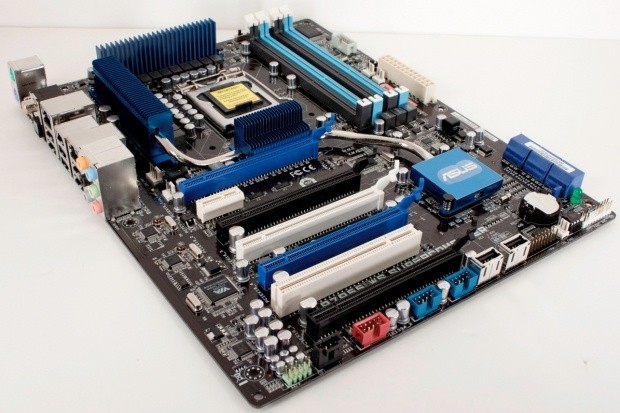
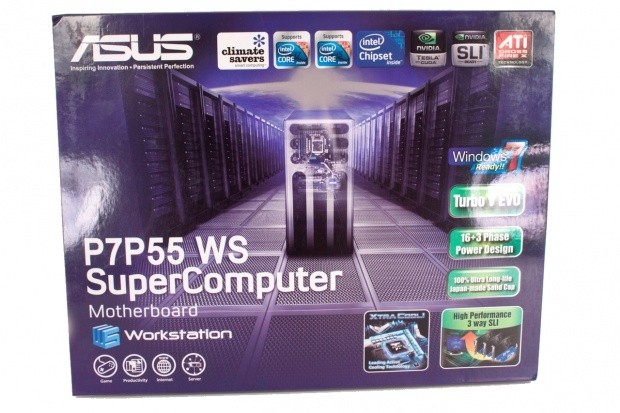
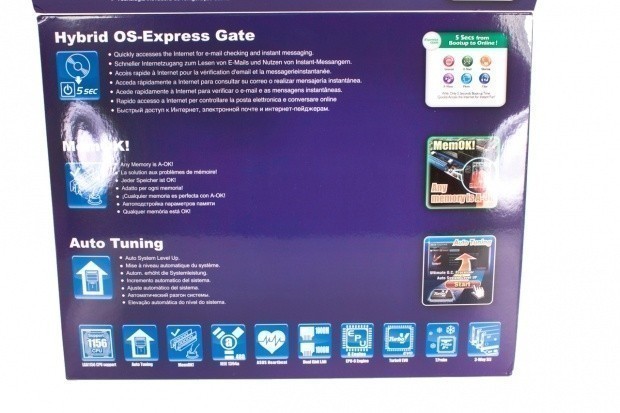
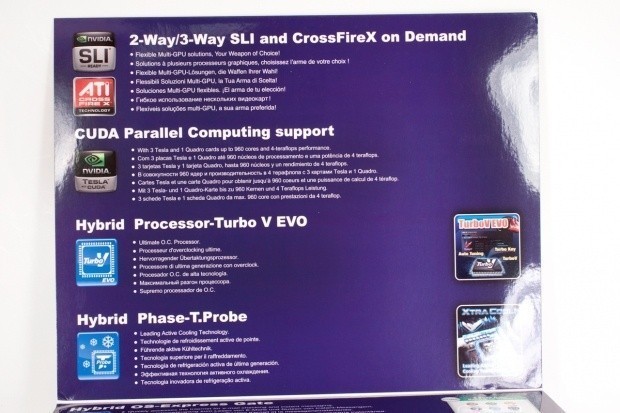

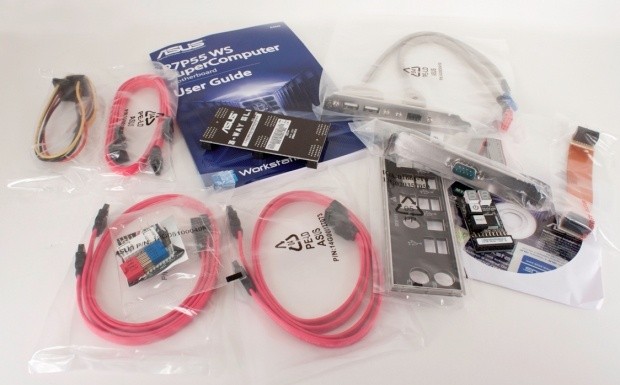
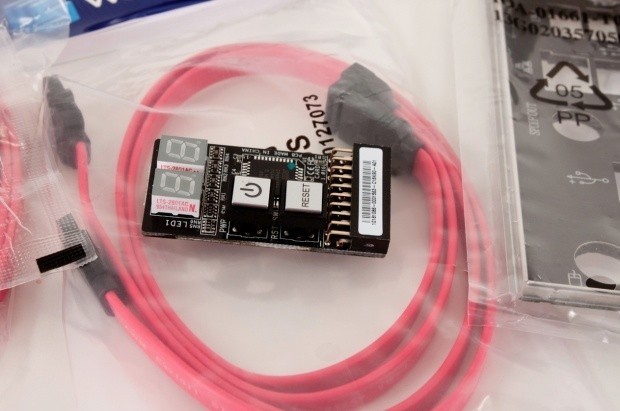
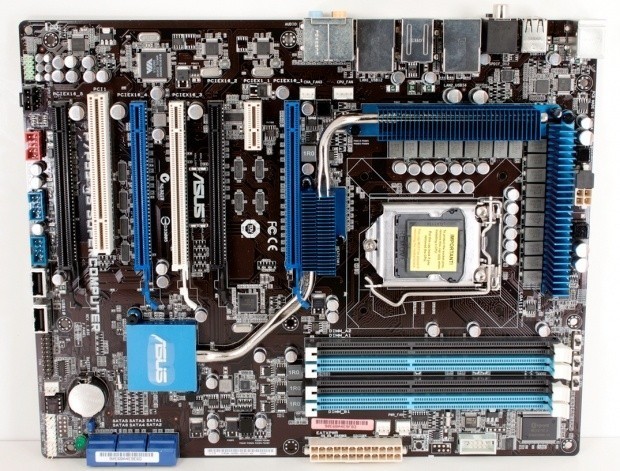
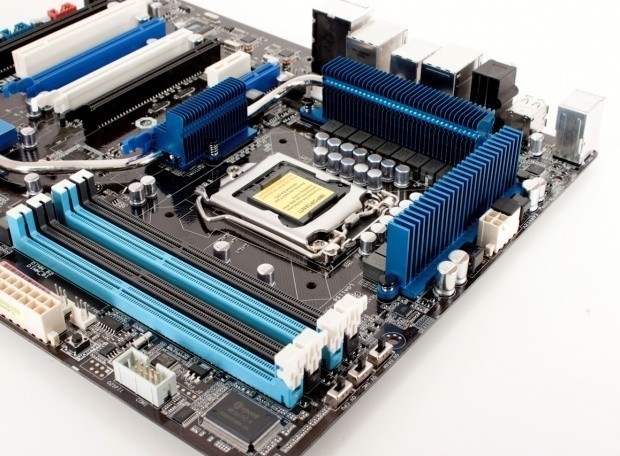
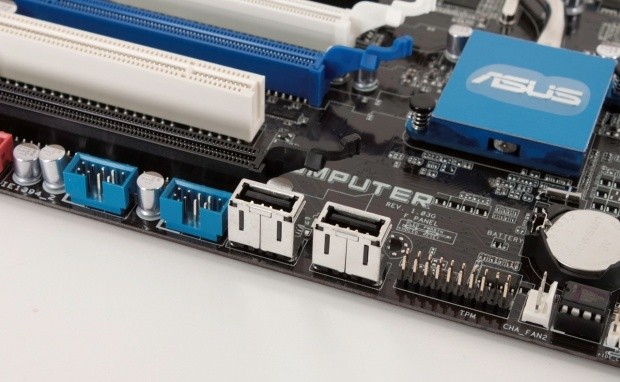

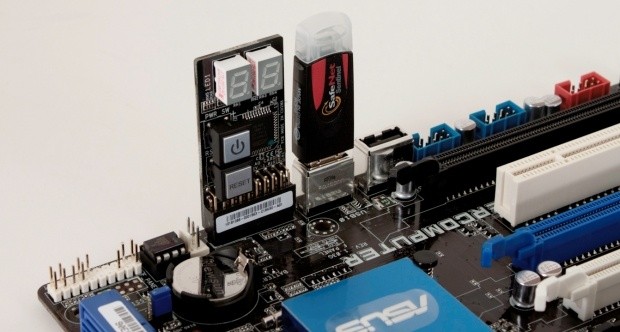
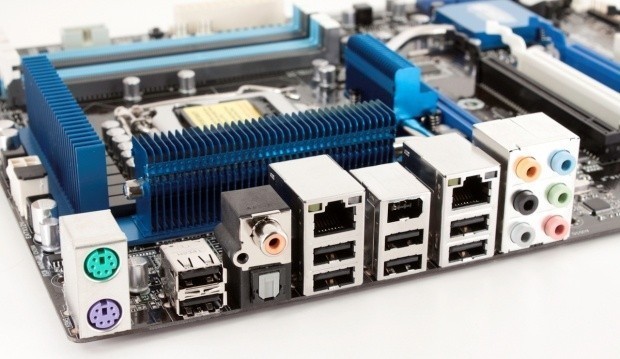
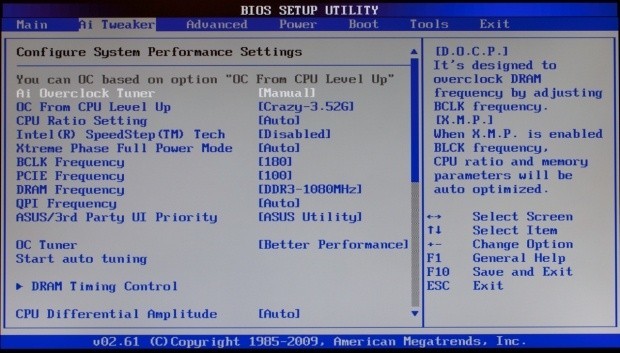
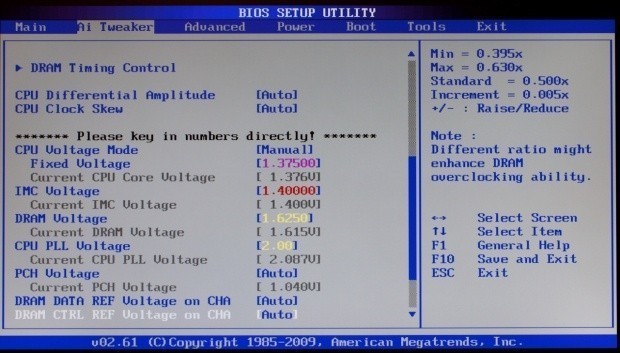
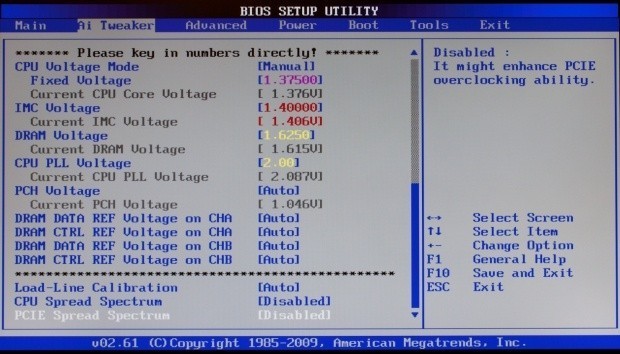
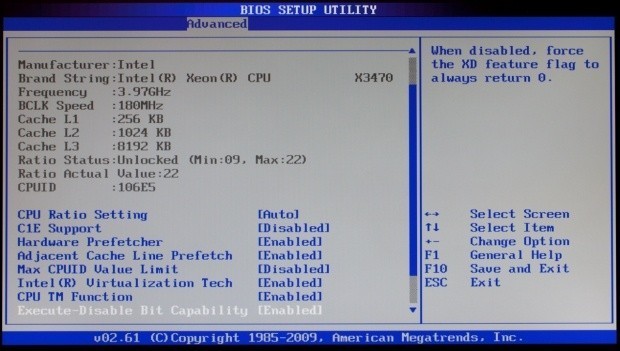
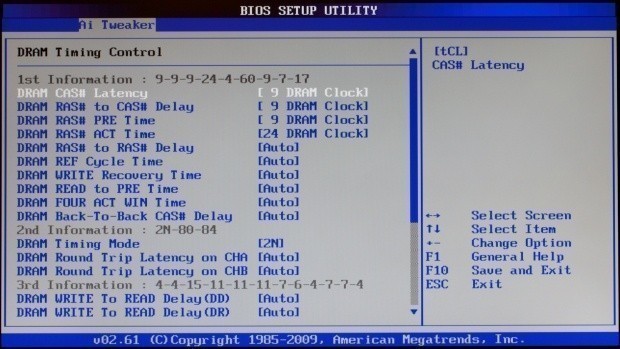
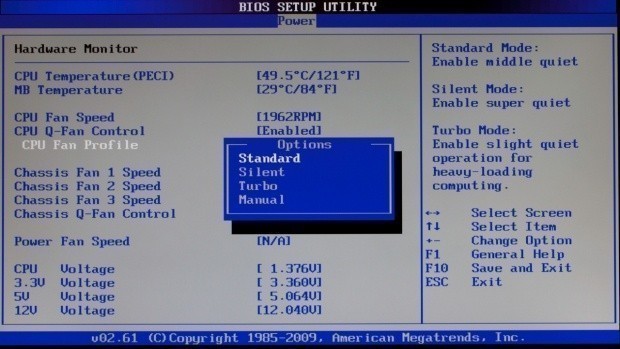
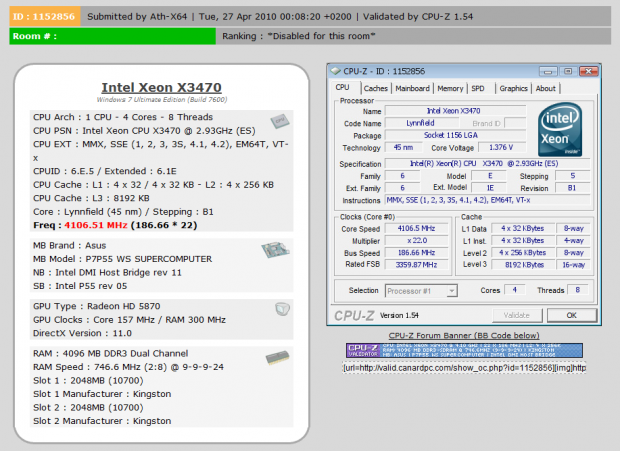
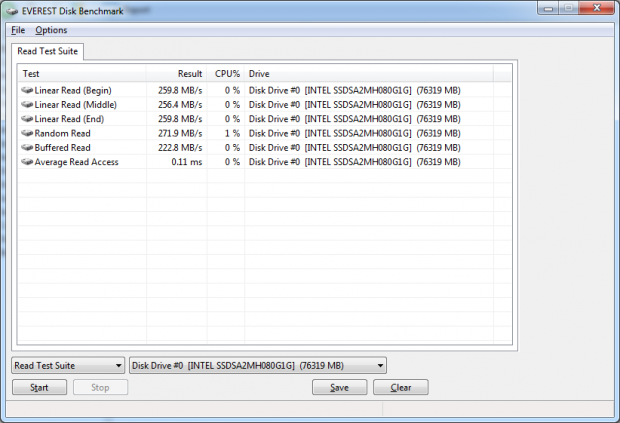
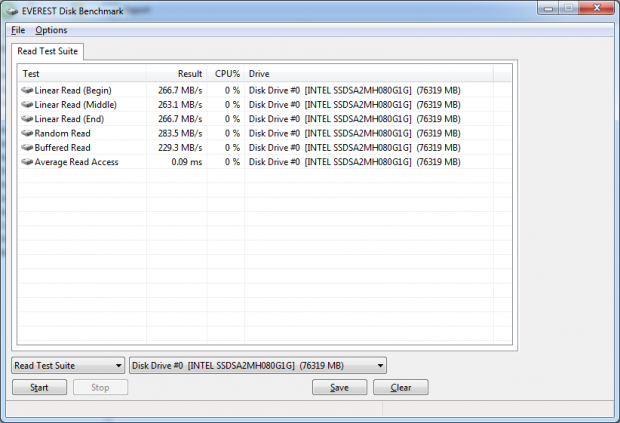

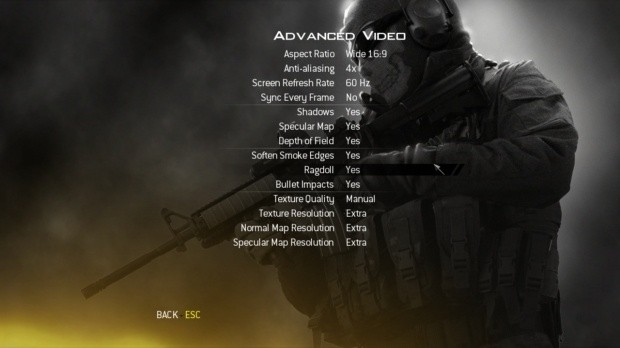
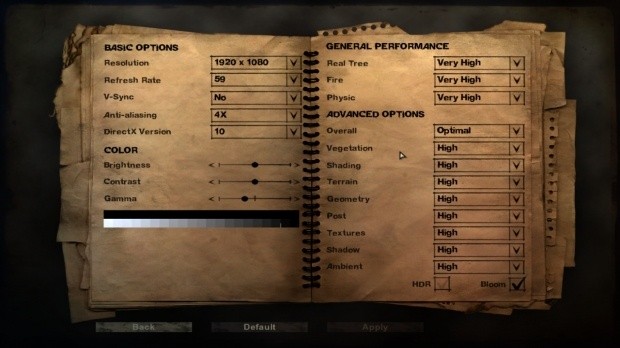
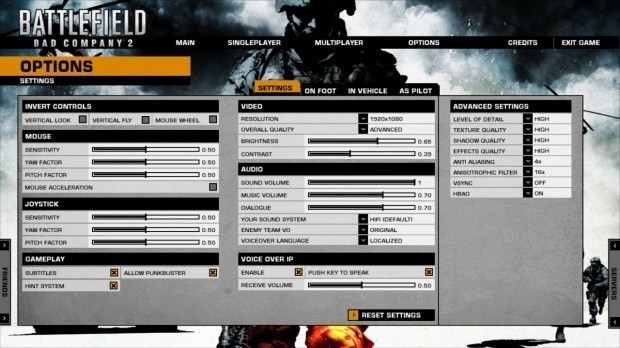

 United
States: Find other tech and computer products like this
over at
United
States: Find other tech and computer products like this
over at  United
Kingdom: Find other tech and computer products like this
over at
United
Kingdom: Find other tech and computer products like this
over at  Australia:
Find other tech and computer products like this over at
Australia:
Find other tech and computer products like this over at  Canada:
Find other tech and computer products like this over at
Canada:
Find other tech and computer products like this over at  Deutschland:
Finde andere Technik- und Computerprodukte wie dieses auf
Deutschland:
Finde andere Technik- und Computerprodukte wie dieses auf